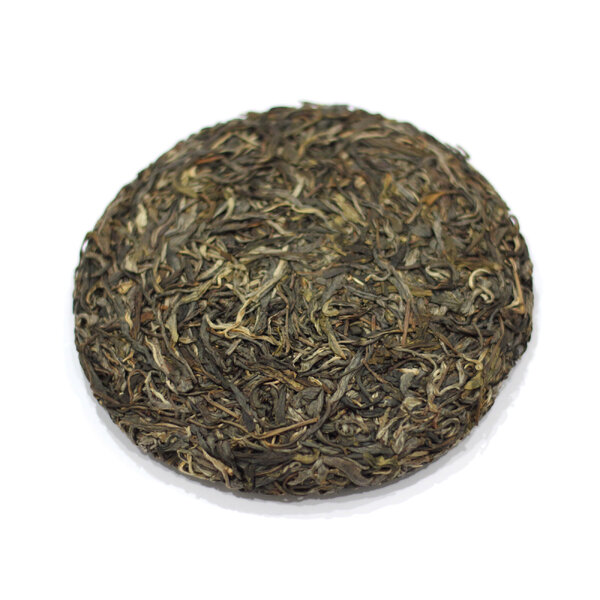Sheng Pu Erh Yi Wu Mahei Xiaoshu Bing Cha
-
Harvest Year 2024
-
Country of Origin China
-
Type of Tea Pu Erh
-
Total Price: 110.00 € (including VAT)
The leaves for this green Sheng Pu Erh, pressed into a traditional Bing Cha cake, come from the village of Ma Hei (麻黑) under the Yi Wu (易武) mountains. They were harvested from 100 years old tea trees that grow here in harmony with the surrounding wild nature.
The aroma reveals layers of herbs, wood, ripe fruit and floral notes, which gently shift and evolve with each infusion.
The flavour shows signs of refined maturation – you can sense how sweetness gradually develops behind the light bitterness and subtle acidity, becoming rounder and more pronounced as the tea continues to age.
The infusion is full yet medium-light, with a touch of fruitiness and soft woody undertones. The tea yields around 12 infusions, making it an ideal companion for long, meditative tea sessions throughout the day.
The village of Ma Hei, nestled among lush mountains, is one of the key regions of Yi Wu, known for producing exceptional high-altitude teas. Tea trees grow directly within the forest ecosystem, which contributes to the distinctive purity and character of this terroir.
This tea is an excellent choice not only for Pu Erh enthusiasts but also for anyone wishing to explore the complexity and aging potential of raw Pu Erh.
We recommend rinsing the leaves with hot water before brewing.
Tea Preparation for Multiple Infusions
-
Tea Quantity 6 - 7 g
-
Water Quantity 200 ml
-
Water Temperature 100 °C
-
Brewing Time 30-45s, 20s, 25s, 30s, 40s, 60s, 80s, 110s, 150s, 200s, 250s, 300s
-
Number of Infusions 12
-
Tea Characteristic Stredne povzbudzujúci
Pu-erh is a Chinese fermented tea originating from Yunnan Province. It is characterised by its earthy, rich flavour, which deepens and mellows with extended ageing. There are two main types: Sheng (raw, light Pu-erh) and Shu (ripe, dark Pu-erh). Sheng undergoes natural ageing, while Shu is rapidly fermented.
Pu-erh is one of the oldest and, due to its effects, most renowned teas.
It is produced as loose leaf tea or pressed into shapes. The most common pressed Pu-erh shapes are:
- Bing Cha (饼茶) – "Cake" or "Disc" – a flat, round shape, most commonly pressed in weights of 357g, 200g, and 100g. Sometimes also referred to as Ping Cha.
- Tuo Cha (沱茶) – "Nest" – shaped like a bird's nest with a hollow depression on the bottom. Often pressed in weights of 250g, 100g, or smaller 5g nests called mini Tuocha.
- Zhuan Cha (砖茶) – "Brick Tea" – rectangular, brick-shaped. Standard weights include 250g, 500g, or even 1kg bricks.
- Fang Cha (方茶) – "Square Brick" – similar to Zhuan Cha but smaller and often more decorative, sometimes divided into smaller squares like a chocolate bar. Typically around 100g to 250g.
It is often consumed after meals and can be stored for many years, with its quality and value potentially increasing over time.
Pu erh tea is considered part of a healthy lifestyle in many Asian countries. Over the years, it has gained popularity not only for its distinctive flavour, but also as part of the traditional lifestyle in many cultures.
It contains polyphenols, tannins, trace minerals (such as potassium, calcium, magnesium) and other naturally occurring compounds that are formed or changed during maturation.
In traditional cultures, Pu erh was consumed mainly after meals, as part of a balanced diet and rituals that promote easy digestion and overall well-being. Not only scientific studies, but also the experiences of many customers indicate its effect on lowering cholesterol.
It is popular among people who prefer teas with a mild stimulant effect and low caffeine content. It is suitable for drinking throughout the day.
Interesting fact: Pu-erh tea collections are highly valued. Many people own Pu-erh collections worth thousands of dollars. In parts of Asia, aged and rare Pu-erh teas are even considered a good investment for the future and may be included as part of a bride's dowry.
REGULATION (EC) No 1924/2006 OF THE EUROPEAN PARLIAMENT AND OF THE COUNCIL of 20 December 2006 on nutrition and health claims made on foods unfortunately prohibits us from making more specific health claims, except for those approved by it. Therefore, we do not make any other claims, even those that have been known and proven over the centuries.



